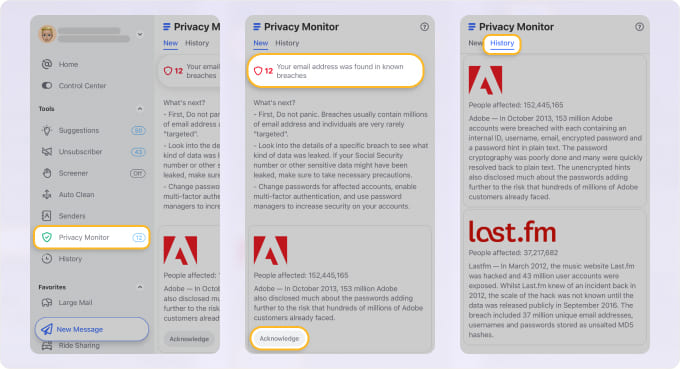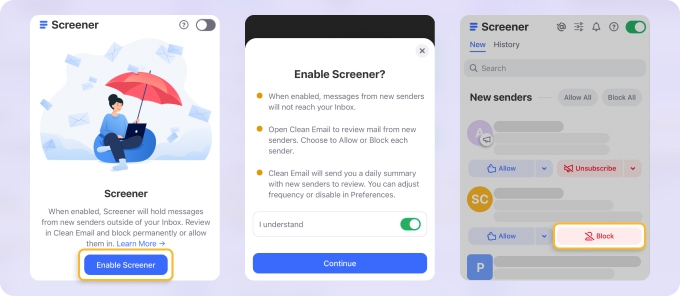Your Email Was Exposed — What That Actually Means
Seeing your email listed in a data breach is unsettling. But it doesn’t automatically mean someone has access to your bank account or personal files.
What it does mean is simpler — and more important.
Attackers now have a verified email address they can build from.
Read More: How Do Spammers Get My Email Address?
Email sits at the center of almost everything online. Password resets arrive there. Security alerts land there. And if attackers want to move quietly, your inbox is where they try first.
That’s why responding to a breach works best when you treat email as the starting point, not an afterthought. Less panic. More order. The right steps, taken in sequence.
Why This Guidance Is Current
Data-breach response advice ages quickly. Attack methods change, inbox behavior shifts, and some older recommendations no longer match how attacks actually unfold.
This guide reflects current, 2026-level breach patterns, based on recent guidance from consumer protection agencies, financial institutions, and real-world incident analysis. It accounts for how attackers now use leaked email addresses today — delayed phishing waves, account-reset abuse, and inbox-level persistence — not just immediate financial theft.
The focus on email-first action, timing, and inbox visibility mirrors how modern breaches actually play out now, not how they worked years ago.
How Leaked Email Addresses Are Usually Used
Most breaches don’t cause damage right away. Instead, attackers tend to:
- Try reused email and password combinations on other services
- Send phishing emails that reference the real breach
- Look for inbox rules, forwarding, or hidden filters
- Use your email to quietly reset passwords elsewhere
Because of this, your inbox is the first system to secure.
First 15 Minutes: Secure the Email Account Itself
Start here. Before anything else.
Do this immediately:
- Change your email password to a strong, unique one
- Sign out of all active sessions
- Review recent login activity for unfamiliar devices or locations
Then check your email settings for:
- Unknown forwarding addresses
- Filters that auto-delete or hide messages
- Connected third-party apps you don’t recognize
These are common ways attackers maintain access without triggering alerts.
This step sets the foundation.
First Hour: Stop Password Reuse Attacks
Once your email is secured, assume attackers will try it elsewhere.
Prioritize accounts most closely tied to your identity or money:
- Banking and payment services
- Apple ID, Google, and Microsoft accounts
- Cloud storage
- Social media
Change passwords anywhere you reused the same or a similar one. Enable stronger authentication where available. App-based authenticators or passkeys are more secure than SMS alone.
This cuts off the most common follow-up attacks.
First 24 Hours: Assess Financial and Identity Exposure
After your core accounts are protected, zoom out.
At this stage:
- Review bank and credit card activity
- Confirm what data was actually exposed
- Decide whether fraud alerts, credit monitoring, or a credit freeze make sense
Not every breach requires freezing credit.
Email-only exposure usually calls for awareness and inbox control, not immediate financial lockdown.
Understanding the scope helps you respond calmly.
First Week: Reduce Phishing Risk and Inbox Noise
This is where many people let their guard down — and where secondary attacks often begin.
After a breach, phishing emails often:
- Pretend to be the breached company
- Ask you to “confirm” information
- Create urgency or fear
- Link to fake login pages
A cluttered inbox makes these messages harder to spot.
At this stage, inbox management tools like Clean Email can help by reducing background noise. It can unsubscribe you from newsletters you no longer read, group repetitive senders, and separate messages from unknown senders so suspicious emails stand out. → Try it for Free
The goal here isn’t productivity. It’s visibility.
Using Clean Email After a Breach
Once urgent security steps are complete, Clean Email can support longer-term cleanup and prevention.
Helpful actions include:
- Checking Privacy Monitor to see whether your email appears in known breaches


- Unsubscribing from unused services to reduce future exposure
- Blocking or silencing repeat senders that often carry phishing attempts
- Managing unknown senders before trusting them (with the Screener feature)


- Automating cleanup rules so clutter doesn’t quietly rebuild
Clean Email never reads your email content and works with all IMAP providers. It simply helps keep your inbox manageable — which matters more after a breach. → Try it for Free
What You Do Next Depends on What Was Leaked
Not all breaches require the same response.
- Email only: Focus on phishing awareness and inbox control
- Email + password: Change reused passwords everywhere
- Phone number: Watch for SIM-swap attempts and SMS scams
- Address or date of birth: Be alert for impersonation attempts
- Government ID or financial data: Credit freezes and long-term monitoring may be needed
Clarity helps avoid both panic and complacency.
How to Spot Fake “Breach Follow-Up” Emails
Breach-related scams often look convincing because they reference real events.
Be cautious of emails that:
- Ask for full passwords or verification codes
- Create urgent deadlines
- Come from look-alike domains
- Link to login pages you didn’t request
Legitimate companies won’t ask for sensitive information by email. When in doubt, visit the service directly instead of clicking links.
After Things Settle: Make the Next Breach Less Dangerous
You can’t prevent every breach. But you can limit how much harm one causes.
Helpful long-term upgrades include:
- Using a password manager for unique credentials
- Enabling passkeys or hardware security keys where available
- Limiting how widely you reuse your primary email address
- Keeping your inbox organized so security messages are easy to spot
Security improves when visibility improves.
Quick Timeline Recap
- First 15 minutes: Secure your email account
- First hour: Stop password reuse
- First day: Monitor finances and assess exposure
- First week: Reduce phishing risk and inbox noise
- Ongoing: Limit exposure and maintain inbox hygiene
Final Thought
A data breach doesn’t automatically lead to identity theft or financial loss. Most serious damage happens when attackers gain time, access, and attention.
By securing your email first, keeping it clean afterward, and staying organized long-term, you remove the paths attackers rely on most — now and in the future.
That’s all you need.


